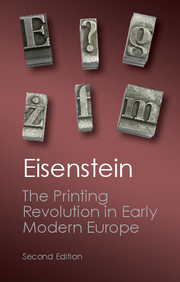Book contents
- Frontmatter
- Contents
- List of Illustrations and Maps
- Preface to the Second Edition
- Introduction
- THE PRINTING REVOLUTION IN EARLY MODERN EUROPE
- PART I THE EMERGENCE OF PRINT CULTURE IN THE WEST
- 1 An Unacknowledged Revolution
- 2 Defining the Initial Shift
- 3 Some Features of Print Culture
- 4 The Expanding Republic of Letters
- PART II INTERACTION WITH OTHER DEVELOPMENTS
- Afterword: Revisiting the Printing Revolution
- Selected Reading
- Index
3 - Some Features of Print Culture
from PART I - THE EMERGENCE OF PRINT CULTURE IN THE WEST
Published online by Cambridge University Press: 05 October 2013
- Frontmatter
- Contents
- List of Illustrations and Maps
- Preface to the Second Edition
- Introduction
- THE PRINTING REVOLUTION IN EARLY MODERN EUROPE
- PART I THE EMERGENCE OF PRINT CULTURE IN THE WEST
- 1 An Unacknowledged Revolution
- 2 Defining the Initial Shift
- 3 Some Features of Print Culture
- 4 The Expanding Republic of Letters
- PART II INTERACTION WITH OTHER DEVELOPMENTS
- Afterword: Revisiting the Printing Revolution
- Selected Reading
- Index
Summary
Granted that some sort of communications revolution did occur during the late fifteenth century, how did this affect other historical developments? Most conventional surveys stop short after a few remarks about the wider dissemination of humanist tomes or Protestant tracts. Several helpful suggestions – about the effects of standardization on scholarship and science, for example – are offered in works devoted to the era of the Renaissance or to the history of science. By and large, the effects of the new process are vaguely implied rather than explicitly defined and are also drastically minimized. One example may illustrate this point. During the first centuries of printing, old texts were duplicated more rapidly than new ones. On this basis most authorities conclude that “printing did not speed up the adoption of new theories.” But where did these new theories come from? Must we invoke some spirit of the times? Or is it possible that an increase in the output of old texts contributed to the formulation of new theories? Maybe other features that distinguished the new mode of book production from the old one also contributed to such theories. We need to take stock of these features before we can relate the advent of printing to other historical developments.
Without attempting to draw up a complete inventory, I have singled out some of the features which appear in the special literature on early printing and held them in mind while passing in review selected historical developments.
- Type
- Chapter
- Information
- The Printing Revolution in Early Modern Europe , pp. 46 - 101Publisher: Cambridge University PressPrint publication year: 2012



